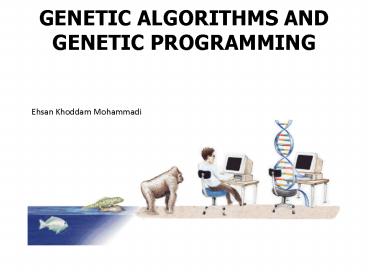GENETIC ALGORITHMS AND GENETIC PROGRAMMING - PowerPoint PPT Presentation
1 / 26
Title:
GENETIC ALGORITHMS AND GENETIC PROGRAMMING
Description:
GENETIC ALGORITHMS AND GENETIC PROGRAMMING Ehsan Khoddam Mohammadi * * * * * * * * * * * * * * * * * * * * DEFINITION OF THE GENETIC ALGORITHM (GA) The genetic ... – PowerPoint PPT presentation
Number of Views:393
Avg rating:3.0/5.0
Title: GENETIC ALGORITHMS AND GENETIC PROGRAMMING
1
GENETIC ALGORITHMS AND GENETIC PROGRAMMING
Ehsan Khoddam Mohammadi
2
DEFINITION OF THE GENETIC ALGORITHM (GA)
The genetic algorithm is a probabilistic search
algorithm that iteratively transforms a set
(called a population) of mathematical objects
(typically fixed-length binary character
strings), each with an associated fitness value,
into a new population of offspring objects using
the Darwinian principle of natural selection and
using operations that are patterned after
naturally occurring genetic operations, such as
crossover (sexual recombination) and mutation.
3
Biological Background
- Chromosome (Genome)
- Genes
- Proteins (A T G C)
- Trait
- Allele
- Natural Selection (survival of fittest)
4
GA FLOWCHART
5
Which problems could be solved by GA?
- Nonlinear dynamical systems - predicting, data
analysis - Designing neural networks, both architecture and
weights - Robot trajectory
- Evolving LISP programs (genetic programming)
- Strategy planning
- Finding shape of protein molecules
- TSP and sequence scheduling
- ?All Optimization Problems (Knapsack,Graph
coloring,)
6
GA Operations
- Encodings
- Initiate Population
- Selection
- Reproduction
- Crossover (sexual reproduction)
- Mutation
7
GA Operations (Cont.)ENCODING(1/3)
- Fixed-Length encoding
- 1D encoding arrays, lists, strings,
- 2D encoding matrices,graphs
- Variable-Length encoding
- Tree encoding binary parser trees like
postfix,infix,
8
GA Operations (Cont.)ENCODING (2/3)
- Permutation Encoding
- Map Coloring problem , TSP,
- Array in size of regions, each cell has an
integer corresponding to available colors. - R1 G2 B3 W4
- Binary Encoding
- Knapsack problem, equation solving ()
- Chromosome A 101100101100101011100101 Chromosome
B 111111100000110000011111
1 2 2 3 1 4 4 1 2 2
9
GA Operations (Cont.)ENCODING (3/3)
- Tree encoding
- Genetic programming, finding function of given
values (elementry system identification)
( do_until step wall )
( x ( / 5 y ) )
10
GA Operations (Cont.)SELECTION (1/3)
- In GA ,the object is to Maximizing or Minimizing
fitness values of population of Chromes. - Fitness Function should be applicable to any
Chromes (bounded). - Mostly a positive number, showing a distance
between present state to goal state. - In NP-Complete or partially defined problems
should relatively be computed . - Two important parameters
- Population diversity (exploring new areas)
- Selective pressure ( degree to which better
individuals are favoured)
11
GA Operations (Cont.)SELECTION (2/3)
- Roulette Wheel Selection (improved by Ranking)
- Sum Calculate sum of all chromosome fitnesses
in population - sum S. - Select Generate random number from interval
(0,S) - r. - Loop Go through the population and sum
fitnesses from 0 - sum s. When the sum s is
greater then r, stop and return the chromosome
where you are - Not suitable for highly variance populations
- Using RANK Selection
- The worst will have fitness 1, second worst 2
etc. and the best will have fitness N (number of
chromosomes in population). - Converge Slowly
1
2
12
GA Operations (Cont.)SELECTION (3/3)
- Steady-state Selection (threshold)
- Fittest just survived
- Elitism
- Fittest selected, for others we use other
selection manners - Boltzmann Selection
- P(E)exp(-E/kT), like SA. Number of selections
reduces in order of growing of age - Tournament Selection
13
F.Nitzche
14
GA Operations (Cont.)REPRODUCTION(1/1)
- Reproduction rate
- Selected gene transfers directly to new
Generation without any change.
15
GA Operations (Cont.)CROSSOVER(1/1)
- CROSSOVER rate
- Single Child
- Single-Point
- 1100101111011111 11001111
- Multi-Point
- Uniform
- Arithmetic
- 11001011 11011111 11001001 (AND)
- Multi Children
16
GA Operations (Cont.)MUTATION(1/1)
- Mutation rate
- Inversion
- Deletion and Regeneration
- For TSP is proved that some kind of mutation
causes to most efficient solution
11001001 gt 10001001
17
GA EXTENTIONS (part 1)
- GENETIC PROGRAMMING
- solve a problem without explicitly programming
- Writing program to compute X2X1
18
GENETIC PROGRAMMING
19
Genetic Programming (1/4)PREPARATORY STEPS
Objective Find a computer program with one input (independent variable X) whose output equals the given data
1 Terminal set T X, Random-Constants
2 Function set F , -, ,
3 Fitness The sum of the absolute value of the differences between the candidate programs output and the given data (computed over numerous values of the independent variable x from 1.0 to 1.0)
4 Parameters Population size M 4
5 Termination An individual emerges whose sum of absolute errors is less than 0.1
20
Genetic Programming (2/4) initial population
21
Genetic Programming (3/4)FITNESS OF THE 4
INDIVIDUALS IN GEN 0
22
GENETIC PROGRAMMING (4/4)
23
REPRESENTATIONS
- Binary decision diagrams
- Formal grammars
- Coefficients for polynomials
- Reinforcement learning tables
- Conceptual clusters
- Classifier systems
- Decision trees
- If-then production rules
- Horn clauses
- Neural nets
- Bayesian networks
- Frames
- Propositional logic
24
GA EXTENTIONS (part 2)
- Multi Modal GA
- SOCIAL MODEL religion based
- Hybrid Methods ( associate with FL and ANN)
25
REFRENCES
- Neural Networks, Fuzzy Logic and Genetic
Algorithms ,Synthesis and Applications - S.Rajasekaran
- G.A.Vijayalakshmi Pai
- PSG College of Technology,Coimbatore
- http//www.smi.stanford.edu/people/koza
- Doctor John R. Koza
- Department of Electrical Engineering
- School of Engineering
- Stanford University
- Stanford California 94305
- http//cs.felk.cvut.cz/xobitko/ga/
- Marek Obitko, obitko_at_email.cz
26
???? ????? ?? ????? ???? ?????!
?? ????































